How to find clothing manufacturers for your business
If you want to work in the fashion and clothing industry, you’ve got a few options available to you. You can work in fashion retail with high street retailers, you might try and get into modelling, or you might start a business DropShipping the latest trends. But if you want to be the one designing the clothes, those routes are difficult to get to the stage that you can be in charge of the designs, and it is incredibly competitive. The solution to getting your designs available to customers might be to start your own business – but making hundreds, or even thousands of garments just isn’t plausible for most designers. That’s where manufacturers come in.
In this post, we’ll take a look at reasons to work with manufacturers and some of the challenges that may be presented when working with manufacturers, both domestic and overseas. We’ll also look at alternatives to using clothing manufacturers, and how you can build your business with those alternatives.
Why work with a manufacturer?
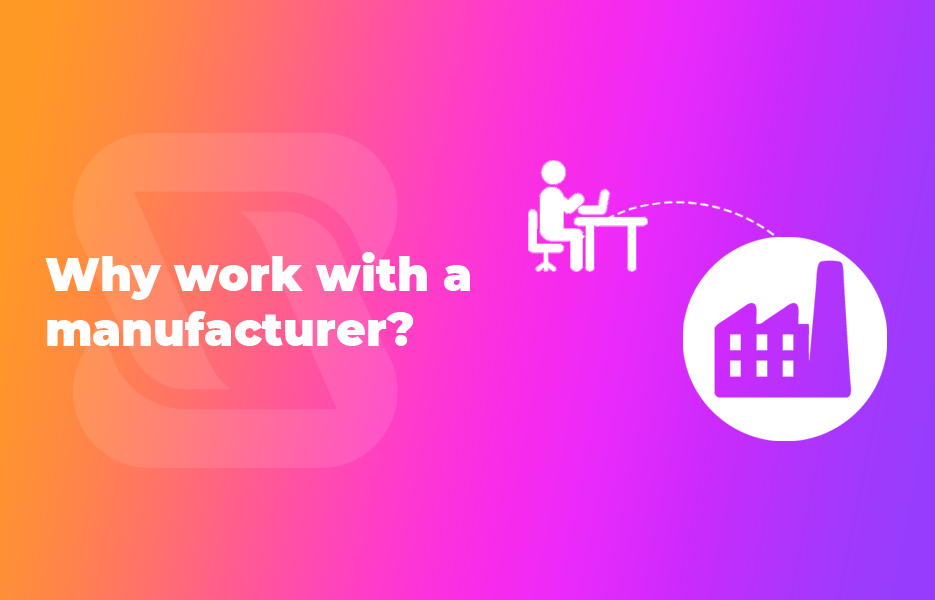
Fashion is one of the biggest sellers online, but it’s incredibly difficult to get a start in, even if you’re a fashion graduate. If you decide to create a business selling fashion items, you’ll need a lot of enthusiasm, and a unique selling point that helps make your brand stand out. If you’re lucky enough to have the talent to design your own clothing, then working with clothing manufacturers might be the best way for you to get your designs into production.
Although setting your own business up is hard work – there is no two ways around it, you’re going to be working hard, it is likely to be easier than trying to get into a job designing for a fashion retailer. Working with a clothing manufacturer is an awful lot easier than creating your own factory and finding your own staff – when you’re setting your business up, at the very least! With the right approach, working with manufacturers means that you will be able to build your business, and sidestep working your way up in the industry so you can go straight to the top – and live your dream.
Bigger capacity
If you want to sell clothing that you’ve designed and you don’t want the hassle of actually making the garments, then it’s pretty clear already why you would work with a manufacturer – you’re saving yourself a huge amount of hassle! Manufacturers and their staff are set up to create huge numbers of garments, very quickly – much quicker than you would be able to do in a one-person operation. Each manufacturer’s capacity is different, but it’ll definitely be much faster than if you chose to make garments individually.
More detailed products
Depending on what you need your manufacturer to do for you, you’ll benefit from being able to produce the styles you want much more easily, even your more complex designs. You’ll be able to specify almost every detail – from the colour of the threads, to the exact type of buttons, through to the number of pleats or darts that you want sewn into the garments.
You can build your brand
Since your manufacturer will be taking care of producing your clothes, you’ll have more time to be able to build your brand much more effectively. You will be able to market your products in the way you envisaged, and you won’t be tied to promoting products that you don’t believe in. You’ll have complete control over everything – where you advertise, which social media you use to promote your business, where you sell – either online or in a high street retail outlet. Using manufacturers is an expense, but it’s an investment in your time, that helps you grow your business.
Unique garments
As your designs are completely unique to you, there won’t be anyone else that is selling your items. That means you’ll be able to charge more for your items, and your profit margins are likely to be that bit higher on each item. Higher profits means that you’ll have more opportunity to extend your product line or add more items to your next order. More products means your business will be able to scale up quicker.
What are the challenges of working with clothing manufacturers?
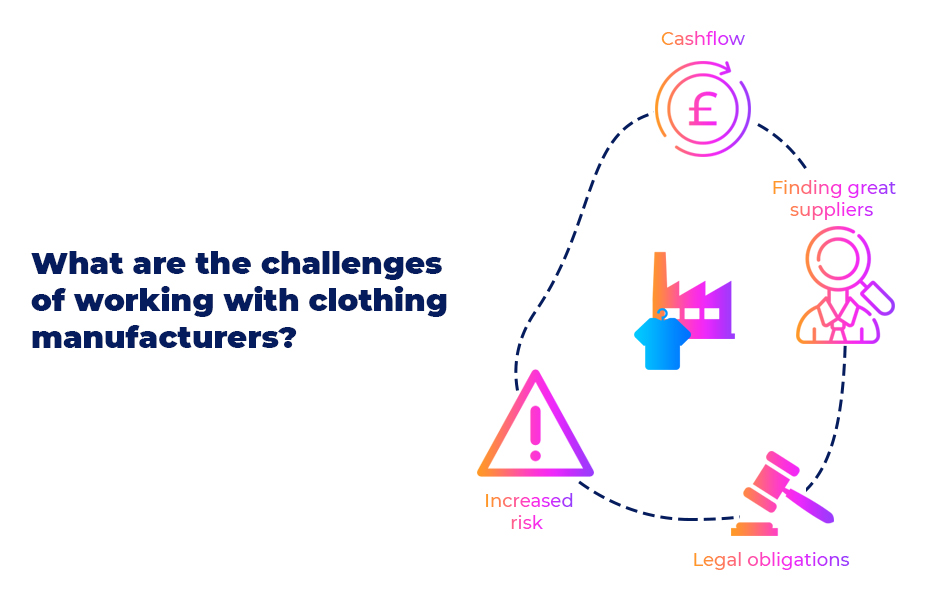
Working with clothing manufacturers might offer plenty of benefits to your business – whatever stage your business happens to be at – but there are some definite challenges that you might need to find solutions for too. If you can’t get round these challenges right now, we’ll be looking at some alternatives that you can consider towards the end of this post. You’ll be able to use these options at any stage of your business – either to grow the cash you have available before you engage with a clothing manufacturer, or to boost your business so you can invest in your own designs further.
Cashflow
We’ve just mentioned cashflow, and for good reason – it’s a concern for every business, whether it is in the start-up phase or it’s a well-established business.
Manufacturers won’t send you products before you’ve paid for them – so you’ll need funds available to invest in your first order. You will need to pay for samples (which is an essential step to ensure that your manufacturer provides the quality you’re looking for) and you’ll need enough to cover the number of items that you want for your collection. Once your money is invested in your stock, you won’t be able to use the cash until you’ve sold the items. Once they’re sold, and ideally, you will have made a profit on each item, you’ll be able to invest the cash and the profits again.
Increased risk
Investing those funds can be a huge risk too. Think about it – if you spend money on ordering your samples, and the sample items are not of the quality that you need, you will have only established who you don’t want to work with. If you find the company that you think might be the right manufacturer for your needs, and you place the order and they mess it up, you’ll be out of pocket. Not only will you be out of pocket, you’ll also potentially be way behind the schedule that you are trying to work to, which means you won’t be making profits when you need them to grow your business. If you’re creating relatively timeless garments, such as t-shirts or jeans, a time delay might be just that – a delay. But if your designs capitalise on the most current trends, a delay could mean the value of your work is wiped out, since you might not be able to charge as much as you would have been able to if you received the order on time.
Legal obligations
Depending on whereabouts in the world your manufacturer is, you might have legal obligations to meet when you are working with a manufacturer – and of course, if you’re importing your items, you might need to deal with customs issues.
Finding great suppliers
Simply finding a good clothing manufacturer might be a challenge too – especially if you need to reduce your costs, which might mean that you need to work with manufacturers overseas.
How to find clothing manufacturers
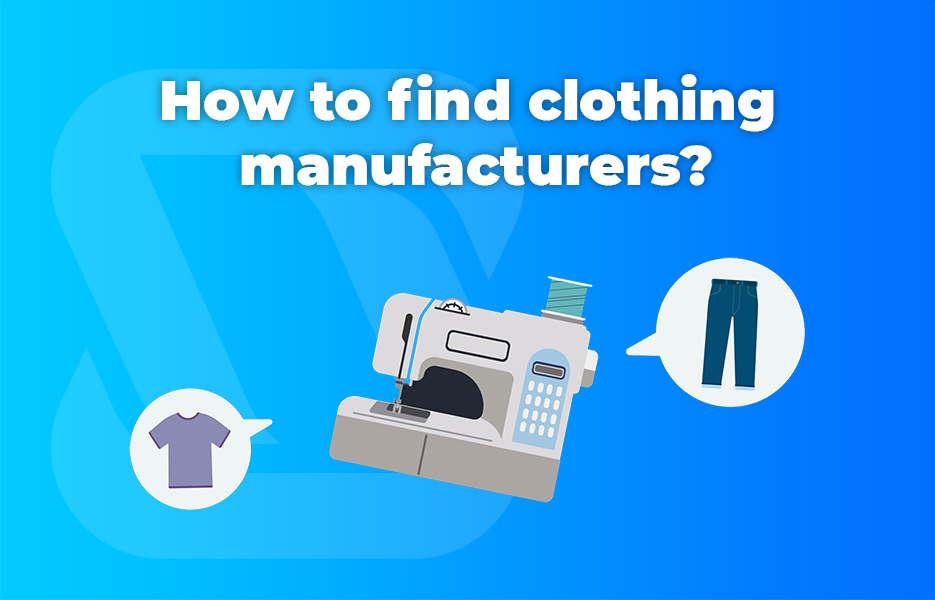
We’re not going to tell you how to create your designs – you’re the expert in that! But once you’ve got your designs, and potentially you’ve run up samples and designed the patterns yourself, then it’s time to look at finding manufacturers. Since you’re going to be depending heavily on your manufacturers – they are going to be the key to the success of your business – you’ll need to be confident that you’ve found the right ones. There’s a few ways to find your manufacturers, so let’s take a look!
Online research
Of course, the first place you’re likely to look when you’re starting to look for clothing manufacturers is online. It goes without saying these days, doesn’t it? However, it might not be quite as easy as that. When we were doing our research for this post, we noticed that there was a lot of businesses that had out of date websites. Some of those manufacturers might be in business still even if their website doesn’t look like it’s had an update for a few years. If it looks like the company can produce what you need, then look to review websites to see if there any recent ones, and give them a call.
Directories
Of course, the clothing industry is well-established – we’ve needed clothes forever! There are some incredible manufacturers doing great things in many countries worldwide, and have been for years, and there are some newer businesses that are providing quality items too. It stands to reason that over the years there has been a massive increase in online manufacturer directories, and databases that hold details for industry contacts.
Sewport is a platform that has a directory of over 900 manufacturers and contacts in the industry worldwide, that you can access when you create an account. Once you’re signed up, Sewport connects clothing designers with the leads that you need to create your products – and other industry contacts that might be useful to help make your business run smoothly.
To use Sewport, you’ll need to sign up as a brand (so you’ll need to have your company name ready, even if you’re not official yet), and create your enquiry. Creating the enquiry then allows manufacturers to respond to you if they can provide the service you’re looking for. This is where Sewport saves you time – you’re sending the enquiry once, and you won’t have to search for email addresses, or filter through emails to find the ones that are telling you they can’t help, or your job is too small. You don’t need to have your designs finalised either though – you can use Sewport even if you’ve only got as far as the sketch stage!
You’ll get replies from businesses all over the world that are happy to work with you, which allows you to choose the right one to work with. Once you’ve received the proposals and you’ve narrowed down the ones you’re interested in, you can request a formal proposal, including payment and delivery terms, and formalise your agreement. Then it’s time to make your payment – which are made securely through Escrow on the Sewport platform. A percentage of the payment goes directly to the manufacturer, and the other part is retained by Sewport until the job has been completed.
The downside is that the Sewport platform isn’t free. You’ll get a seven day trial, but once you’ve completed that, it’s £18.75 a month to continue to see your enquiries, proposals and estimates. That’s a pretty small price to pay – and depending on how much you need from your manufacturers, once you’ve made the connection, you might not need to remain a subscriber.
If you’re not at the point of needing the Sewport platform yet, or you’re not ready to sign up, there are useful and informative posts on their blog – including information such as how to do a successful fashion photoshoot, and a guide to starting a children’s clothing line.
Make it British is an incredible resource if you’re looking for manufacturers in the UK. You can buy the complete list of manufacturers for just £99, but there are many links available on their website if you don’t have funds to invest right now. Make it British also run events for networking (that are on hold until the COVID-19 crisis is over) and the website also has a blog that is packed full of information that you might find useful too.
Sqetch is a resource with free and paid options available. It’s a bit like Sewport, in that it is a platform for finding and working with manufacturers and related companies in the industry. Sqetch has a significant advantage over Sewport though – they have a much bigger database, with over 3500 manufacturers and suppliers that designers and sellers can access for free. Not only that, you can add up to five project requests monthly at no cost to you – which is great news for businesses that are just starting out and every penny counts. If you need more projects each month than that, there are paid memberships available that also offer access to more extensive functionality on the platform.
Working with an agency
If you’re finding it hard to narrow down your search, or you don’t have the time (or inclination!) you can consider working with an agency. Manufacturing agencies are simply companies that have plenty of contacts in the industry on their books, and know which companies specialise in different products. They’ll provide you with contact details for the most suitable manufacturers for your needs, and will be able to guide you through the process. Some will act on your behalf too – so if you’re looking for a time saver, this could be useful, but you’ll need to bear in mind that there is likely to be an additional costs involved.
DSA Manufacturing is an example of a manufacturing agency. They work with manufacturers and designers worldwide, and their aim is to help companies find the right manufacturers, while lowering the risk of working with manufacturers overseas. They’re based in the UK, and working with a domestic company means you’re more likely to achieve the results you’re looking for, because there are likely to be fewer communication issues – you’ll be speaking the same language, at least!
DSA’s operations means that they will give you an all-inclusive price for the work, shipping and any other associated fees. This means you’re less likely to encounter unexpected payments, and because DSA already have a working relationship with those companies, you’re much less likely to be much more satisfied with the outcome. They’ve got a huge network of other contacts, including web design, web marketing, garment designing and photography – meaning you might not need to spend time on anything other than designing, and working on building your brand.
Social media
Facebook can be absolutely invaluable in terms of finding contacts, and groups that can point you in the direction of great manufacturers. Many members of groups like these were once where you are now – and they are happy to impart the knowledge that they discovered on their way to success (or otherwise!). You might also find active Facebook pages for those manufacturers that have really out of date websites.
LinkedIn is an ideal resource for finding contacts within the industry too – so be sure to create a profile that explains who you are and what you’re trying to achieve. Once you’ve got your profile set up, start to follow people and hashtags, and comment on posts, so you start to be recognised by key individuals in your industry.
Other social media can be a source of information too, of course – these are just two ways of connecting with people that we know work effectively when you’re trying to get into an industry. Following key individuals and companies on Instagram, Pinterest and other social media platforms is a good idea – you never know when the right opportunity for you will present itself.
Peer research
Once you’ve connected with people, either on social media or at industry events, start to reach out to them. There’s no reason you can’t call or email someone and chat to them about a business opportunity that you’re working on. It might take a while – remember, they’re likely to have a lot on their plate – but with the right approach, you can make the connection that takes your business to the next level. Once you’ve made those connections, reach out and offer to meet for a coffee, or to have a quick video call – those short interactions may build into something much, much bigger!
Industry events
When you’re setting up a new business, you need to know your associates, and the companies that your business relies on aren’t going to let you down. Although you can learn a lot from review websites and from speaking with others that have engaged with your supplier, there’s no substitution for meeting people and knowing what your gut instinct tells you.
The Avasam team absolutely adore trade shows and meetups – apart from getting us out the office, industry events give us opportunities to connect with people that we wouldn’t have had the chance to see otherwise. Over the last year, (amongst others!) we’ve been in attendance at Linn Academy, Spring Fair and Autumn Fair, and White Label World Expo – all of which were fantastic events. We met up with plenty of sellers and suppliers at each of these events, as well as meeting contacts from companies providing payments solutions and those in the shipping and logistics sectors. We can’t tell you how useful these events are to your business – but no more so than when you’re starting your own clothing business! Many of these events are free to attend, (although you’ll usually have to sign up to get your ticket) so you’ll just need to cover the cost of travel – which makes it well worth your time.
Choosing a clothing manufacturer
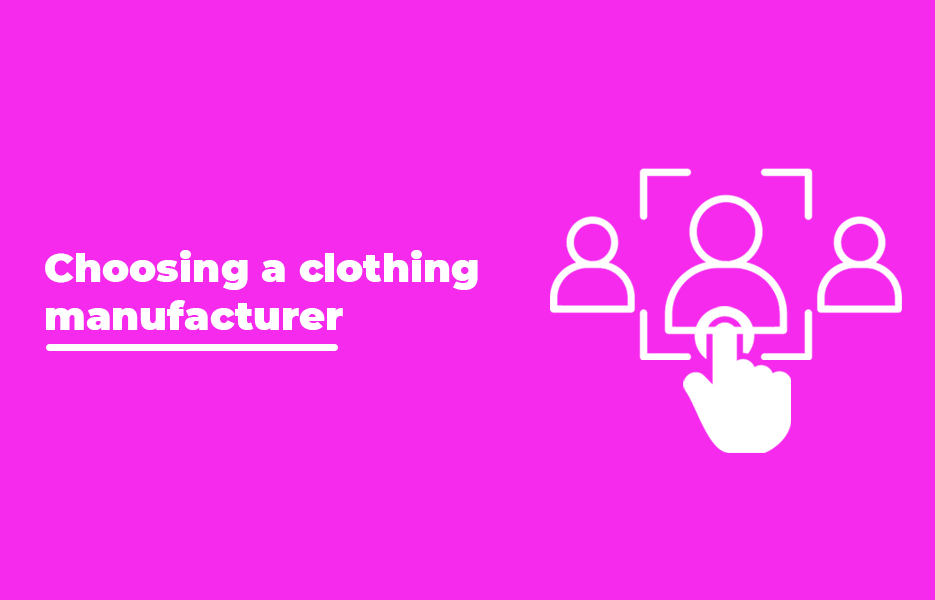
Once you’ve collected all your potential contacts, you’re likely to have an enormous list. You’ll need to narrow down the manufacturers that you’re interested in working with – you’re unlikely to have stacks of cash to order samples from all of your shortlist, and that’s probably unnecessary if you’ve carried out enough research anyway.
When you are narrowing down your list, you’ll need to consider price per item, the amount of time it takes the order to arrive, the quality of your manufacturer work and the levels of customer experience they provide. You’ll be looking to balance keeping the costs as low as possible with the best quality, and the right amount of service. Here are some other things you’ll need to keep in mind.
Domestic or overseas manufacturers?
When you start searching for your manufacturer, you’re bound to find options in the same country and overseas. You’ll probably find that overseas manufacturers are significantly cheaper, but there are many issues that might persuade you to use a domestic manufacturer.
Overseas manufacturers
Like we’ve just said, the main advantage of working with overseas manufacturers is that generally you’re going to be able to access much lower costs, and since you have the rest of the world to find factories, you’re likely to have a much greater choice of manufacturers to work with.
There are plenty of challenges when it comes to working with overseas manufacturers though. Many customers – particularly those that prefer their clothes made by domestic manufacturers – see clothing made overseas as inferior in quality, or that the people making clothes overseas are likely to be exploited. That can be a big thing to get past, and if you work with manufacturers overseas, you might want to add a page to your website detailing exactly where your products come from – especially if you have made the effort to go and visit your manufacturer before you started working with them, and you have photographs. If you’re proud to be associated with that manufacturer, make it clear! You’ll be reassuring your customers, and you’ll be doing your manufacturer a favour too – meaning you’ll be strengthening your working relationship with them.
There’s a major challenge with your products being manufactured overseas: the fact that your items are overseas! That means there’s a whole lot of issues to overcome – from communication barriers and time zone differences to cultural issues when getting started, to shipping times and costs being higher, and potential import duties that will be due when the shipment reaches your country. You’ll also be facing increased financial risk – different legislation in different countries can leave you exposed, and you might not have any protection if a manufacturer suddenly goes out of business.
Although there are many challenges of working with overseas manufacturers, they can still be the right solution for many designers. You’ll just need to know how to mitigate those challenges – so be sure to carry out extensive research, and consult with other designers and sellers before making any decisions.
Domestic manufacturers
Working with suppliers in-country offers a number of benefits – first and foremost, you’re going to be able to market your products as ‘Made in the UK’ – or wherever you’re based! As consumers become more ethically and socially conscious, where their products are made is increasingly important, so you’ll need to bear this in mind.
You’ll avoid costly shipping fees by working with domestic factories, and you won’t encounter any customs fees or shipping delays, which if your collection is time-sensitive, is a huge reason to use a manufacturer in-country. Aside from that, you’ll be able to visit your manufacturer much more easily too – which means increased trust and potentially, a much stronger working relationship. The time you’ll save by not having to ship your order from overseas is all time you can spend photographing your items, and creating marketing materials.
The biggest downside to working in-country is the probability of higher prices. If you’re in the UK or US, there are minimum wages, stricter legal requirements and other factors that will push prices up. That might be an issue initially, but it does offer you a potential marketing opportunity – being able to highlight that your garments are made in country.
In addition to higher prices, there are also a smaller number of factories available to you if you want to use domestic manufacturers. That makes sense when you think that almost every country in the world has manufacturers somewhere – even if there’s just a few. Restricting yourself to working with just one country – unless you live in one of the clothing manufacturing powerhouses, of course – will decrease your options drastically.
Leading on from there being fewer factory options, you’re likely to also find a smaller range of products are actually available to you. Some items are exclusively made in other countries today, due to the techniques or machines required to make them. That might mean if you’ve got a range of designs that includes different product types, you’ll need to use several manufacturers across a number of countries – which could get complicated.
CMT or FPP?
How much of the production do you need your factory to do? If you have created patterns for your designs, or you’re a dressmaker or tailor yourself, then you’re likely to be looking for a factory that does CMT – that’s cut, measure and trim. If you need the factory to create the patterns for you as well, then you’ll need an FPP factory – a full package production. As you would expect, full package production will cost you more – but you’ll be saving time and effort that you can invest in working on your designs, and marketing your products. Establishing which service you need will help you to decide which manufacturer is right to work with.
What size order do you need?
Many manufacturers will require a minimum order size. Some may allow you to order as few as 50 items, but this is not the norm – generally, you’ll need to order 200-300 items at least. You’ll need the funds available to order the items of course, but you’ll also need to be certain you can sell all the items that you order from your manufacturer. If you’re left with items that don’t sell at full price, you’ll need to mark them down in price or put them on sale, or you might be left with dead stock – which represents your money tied up.
Getting samples
You wouldn’t buy a car without test driving it, would you? Of course you wouldn’t. The same goes with the products for your business! You need to be sure the manufacturer you’re working with is going to provide the quality you need, and they’re going to use exactly the right type of supplies for your garments – especially for details like zips and buttons. When you’re first in touch with your manufacturer, be sure to find out whether they can provide you with samples before you place your order, and find out how much your samples are going to cost.
You’ll need to carefully assess the quality of the samples your proposed manufacturer sends. The quality of your garments are going to make or break your business – so if your manufacturer provides you with poor quality items, your business will be affected. Poor quality products will lead to damaging negative reviews, and you won’t be able to charge as much for poorer quality items – so it might be worth choosing a manufacturer that costs slightly more in order to secure better quality products.
Manufacturer capacity
When you’re working to get your business up and running, you won’t be likely to be worrying about the manufacturer’s capacity. But if your business takes off dramatically and you sell out quickly, your customers won’t want to wait for months for your next collection to drop. Find our how quickly your manufacturer can produce the same order again, and what kind of lead time they need. This will also help you plan if you’re expecting to produce new collections or add extra items each season.
Fees and shipping costs
When you’re excited about seeing your designs brought to life and you’re facing the prospect of actually making sales, there’s a chance of getting carried away. You have to be sure you do your due diligence – make sure you know if there are any extra fees that you’ll be liable for, how much shipping will cost and how long the shipping times are likely to be. These are all important factors in your final decision of who to work with, so be sure to get that information early.
Who else have they worked with?
Ask your manufacturer for names of businesses that they have produced items for. Once you’ve got them, you can have a look at websites, social media and reviews to see what customer feedback has been like. If you can, get in touch with the companies that worked with them. If they’re happy with the manufacturer’s work, they will be happy to tell you – and if they don’t recommend them, they are likely to tell you too.
Visit your manufacturer
If it is at all possible, it’s advisable to visit the factory before you make your final decision. You might have met the manager at a trade event, seen their work and you might have had a huge email exchange with them, but if you haven’t visited the factory, you won’t be able to understand how the company works. There’s no reason you shouldn’t request a visit, and indeed if your request is refused without good reason, then be cautious. It’s normal for a designer to visit their manufacturer before they decide to work with them.
Of course, if you’ve chosen a manufacturer that’s overseas, that might not be possible right now, or in your budget – so if you’re not going to be able to visit, be sure to do extensive research. See if you can get the contact details of other businesses that have worked with the manufacturer, and speak with them to find out their experience, and if they visited. If you’re working with overseas manufacturers because they are cheaper, then you’ll need to be careful that the staff they have working for them aren’t being exploited. As some high street brands have discovered, consumers today are much more socially conscious in their choices, and not knowing who is making your garments is not an excuse to ignore the issue.
Do you really need a clothing manufacturer?
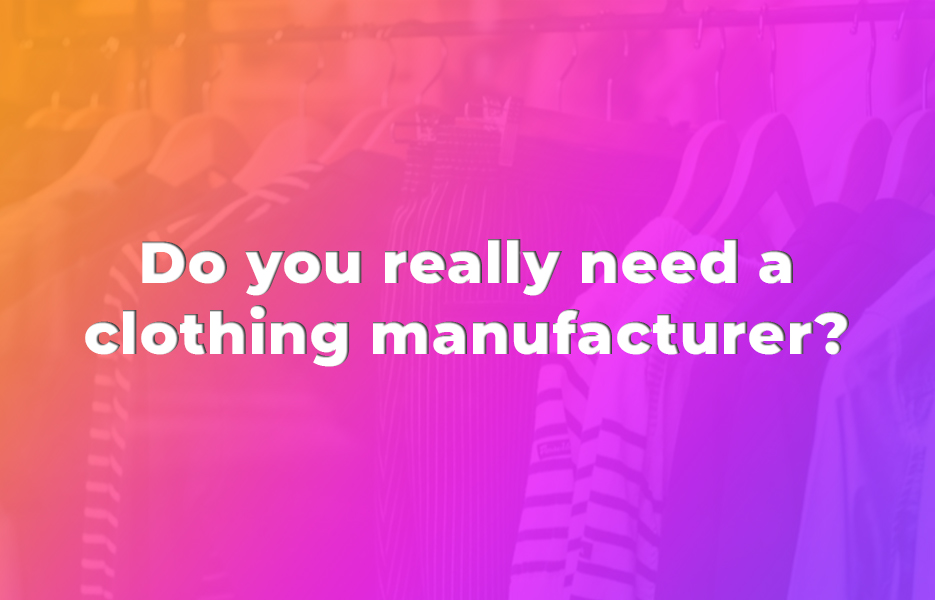
Before you jump straight in and commission a manufacturer to create your own clothing, think about what you want to achieve with your company. If you’re on a mission to create a fantastic line of t-shirts and hoodies, you might not need to start with a manufacturer as you get your business off the ground. And if you’ve only got a small line designed right now, you can increase your offering and fill your eCommerce store immediately by working with DropShipping suppliers.
Wholesale clothing manufacturers
If you have access to a storage facility and you have funds available, then starting your business the other way around – with clothing that is already designed and available – can be a good way to build the cash in your bank. Using wholesale clothing manufacturers to procure those lines means that you’ll be able to buy large amounts of stock at lower prices. You can then sell that stock at a higher price through your website or at a retail outlet, and use the profits to create your own line – which you can promote as exclusive, and charge a higher price for.
Print on demand clothing
Print on demand is a business model that you can use to create products with custom designs printed on them. Items are produced by print on demand suppliers, one at a time, as customers place their orders. For clothing designers, this opportunity typically will extend to t-shirts and hoodies, clothing for children like baby grows, sleep suits and onesies. Print on demand can also extend to accessories like bags and hats, or you might offer promotional items like mugs or posters.
The benefit of print on demand to owners of businesses is that there is only minimal risk involved. Once you have your designs (which you’re likely to have created yourself), there are few costs associated with print on demand products. You won’t pay your supplier until you’ve received the order and payment from your customer, and you won’t need to invest in blank items – so your money stays in the bank, where you can use it for other business opportunities.
You won’t encounter storage costs for your print on demand items – because you’re ordering one at a time from a supplier – and there won’t be any waste either. If one of your designs turns out to be unsuccessful, you can just remove it from your offering. That means you won’t need to hold sales (reducing your potential profit) to clear dead stock!
Of course, as a designer, the biggest thing you’ll be interested in is having complete control over your products. Print on demand items won’t give you the ability to control every aspect of your designs, but you’ll be able to pick which items your designs are allowed to be applied to.
Of course, if you’re creating print on demand clothing, you will need promotional photos – but you won’t need to order one of everything. There are plenty of free, and inexpensive mock-up tools available, which will allow you to create the look of your products before you have even seen one. Indeed, it is possible that you might never see one of your products – although it’s a good idea to order at least one sample, so you know the quality of the basic product before you start selling.
DropShipping clothing and accessories
DropShipping is a method of retail where sellers can sell products without owning the stock. When a customer places an order and makes payment, the seller immediately buys the item(s) from a supplier. The supplier then picks, packs and dispatches the items from the order to the customer directly. The seller never sees, or handles the product.
Reasons to DropShip clothing and accessories
- If you’re starting out as a new brand, and you’ve only got a small signature line of your own designs, you might decide to complement your line and expand your offering with items from other clothing suppliers.
- If you don’t want to invest in stock, or don’t have the funds available to get your designs made, you can start to generate the funds you need by DropShipping clothing and accessories.
- If you’ve got your clothing designs already being made but you need accessories and footwear to complement your items, then DropShipping can increase your profits without you needing to invest, store or ship those items.
- If you aren’t able to create your own designs for some reason, or you encounter problems with a manufacturer, using DropShipping can keep orders – and therefore cash – flowing into your business while you resolve the issue.
DropShipping has many benefits to sellers, and clothing designers in particular. There are no restrictions on the numbers of items that you can sell using DropShipping, and you can stop and start selling items almost instantly – which allows you to capitalise on trends quickly, and stop when customers lose interest. Because you’re not buying the items, if a particular product doesn’t sell then it’s less of a problem than it might be – because your supplier is dealing with storage and shipping the stock.
Once you have an eCommerce website – which are easy to set up – then DropShipping is easy to start, and there are no payments required up front. Since there is no investment in stock required, the profit that you make on each item can be put towards investing in your own designs.
If you’re using DropShipping to help grow your investment in your own designs, when you reach the point that your DropShipping has generated enough funds and you place the order for your designs, you can sell them as an exclusive range on your website. That means you’ll already have built a customer base, and you’ll be keeping your customers interested.
When you’re looking for DropShipping suppliers for your fashion items, then the easy way to find them, and to work with multiple suppliers is to use a DropShipping platform. In addition to helping you find suppliers with different items to sell online, the best DropShipping platforms connect to sales channels – not just your website, but marketplaces like Amazon and eBay, which means you can sell DropShipped items to customers worldwide.
What else do you need for your clothing business?
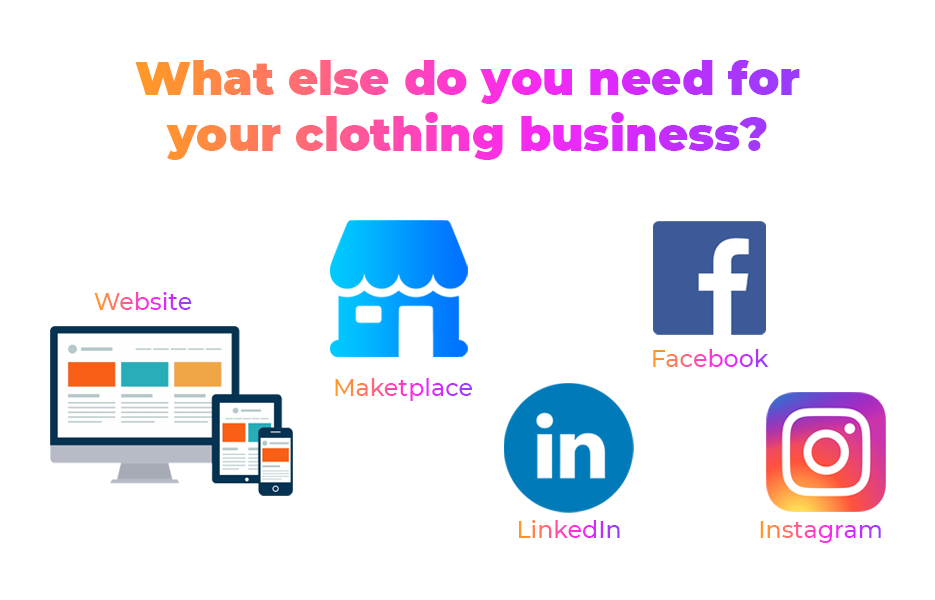
Once you’ve made connections with your manufacturers and your order is placed, there’s plenty more work to be done! You’ll need to make sure your business is registered with Companies House, and you’ll need to make sure you’ve got your accounting sorted – whether you take care of your books yourself, or you employ the services of an accountant. Either way, don’t forget to do that – you don’t want to receive a fine because you forgot to file the appropriate paperwork! On top of the necessary business admin, here’s a few things to consider:
Your website
You’ll need an eCommerce website with plenty of functionality. If you’re going to be selling a mix of items that you hold stock for and DropShipped items, be sure to choose an eCommerce website solution that has plenty of functionality and has integrations for your DropShipping platform. Many businesses choose WooCommerce, Magento or Shopify, but they’re not the only solutions, so be sure to look at your options carefully.
Your marketplaces
If you’re interested in fashion, you’ll see it everywhere – from supermarkets to the high street, and on marketplaces such as Amazon and eBay. Since so many consumers today rely on marketplaces far more than they do on individual websites, you’ll need to consider whether you’re going to sell through marketplaces, or if you’re going to sell your items purely through your website. Even if you decide to sell to domestic customers purely through your website, you can extend the reach of your brand, and increase your profits by selling on international marketplaces – so be sure to choose your sales channels, and your international strategy for growing your business carefully.
Your social media
Social media offers you the opportunity to increase the reach of your brand with little to no cash investment required. While you’re creating your designs and waiting for your order to come through from your manufacturer, you’ll need to grow your social media following. Create your social media channels with your target customer in mind – and don’t forget to create a LinkedIn profile so that you can grow your industry connections. Once your social media is set up, you’ll need to create the sort of content that your customer wants to see, so they remain engaged with your brand and share your content.
Setting up your own clothing line isn’t for the faint of heart. There is so much competition that you’re up against even before you decide to create your own designs, you might decide not to even bother. But if you’re going to create designs anyway, then make use of them! Whether you decide to start your business by investing in stock and working with manufacturers, or you decide to start building your brand by DropShipping, planning your business strategy carefully and building your business can lead you to success.
- If you have cash to invest, choose your clothing manufacturers carefully
- Use resources to narrow down your clothing manufacturer
- Order samples
- Meet your manufacturer in person where possible
- Be sure to visit your manufacturer’s factory before placing your order if you can
- Use wholesalers, print on demand or DropShipping to start, or to expand your business
If you’re going to be using DropShipping as part of your business strategy – either to start your business and build funds before you order from a manufacturer, choose Avasam for your DropShipping operations. With all your processes automated, your time will be free to build your business – and to carry on designing. Your account is free to sign up, and there’s no upfront investment required.

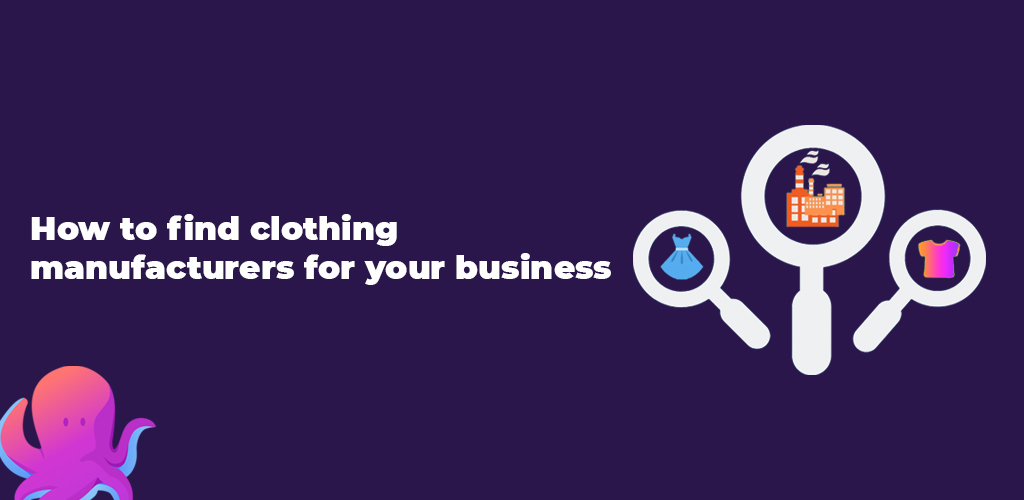






DropShip products from verified suppliers to diversify your inventory and scale your eCommerce business